If you're looking for authoritative information on Hindi Archiveshow much cooling is enough for your CPU, you'll be hard-pressed to find an answer. While we all know that modern processors need some degree of active cooling, very little official information exists to say how different temperatures affect a CPU's performance.
Editor's Note:Older CPUs would simply fail if they started to overheat, but modern CPUs adjust their frequency based on temperature (among other things) to prevent a dramatic failure. Because of this, it stands to reason that once you reach certain temps, you will no longer be getting the maximum performance from your CPU because it will be busy protecting itself.
But what is that temperature? And do you really need a high-end liquid-cooled system to get peak performance, or is the little stock cooler that comes with most CPUs enough? In this article we will answer these questions and more.
Modern CPUs are able to adjust their operating frequencies through a number of technologies in order to either reduce their power consumption or provide maximum power as needed. The first of these modern technologies is Turbo Boost (or Turbo Core for AMD APU/CPUs). According to the overview page for Intel Turbo Boost Technology 2.0, there are five factors that affect the amount of increased frequency an Intel CPU can achieve via Turbo Boost:
For this article, processor temperature is the main factor we are concerned about. You would expect Turbo Boost to slowly stepping back the amount of Turbo Boost as the CPU gets hotter. In actuality, an Intel CPU under heavy load will actually run at the maximum Turbo Boost allowed by the other four factors until it hits the CPU's thermal limit.
CPUs also have extremely robust thermal protection. If the CPU starts operating above the CPU's thermal limit it will begin to reduce the frequency in order to prevent catastrophic failure. Oddly, we have found that the thermal limit for both Turbo Boost and thermal protection on Intel CPUs to be right at 100 °C - which makes it very convenient to remember. In other words, until the CPU hits 100 °C you should see 100% of the CPU's available performance. Once you starting hitting 100 °C, however, the CPU will start throttling back to keep itself from overheating
We know from both experience and explicit testing that modern Intel CPUs (at the very least Sandy Bridge, Ivy Bridge, and Haswell) can run at their maximum Turbo Boost frequency all the way up to 100 °C. While there may be a tiny performance difference between a CPU running at 30 °C and one running at 95 °C, our testing has found that the difference is miniscule. In fact, even after running benchmarks dozens of times the difference is so small that it is essentially nonexistent.
What we canmeasure is what happens once a CPU starts to hit 100 °C. To figure this out, we took an Intel Core i7 4790 and cooled it with a Gelid Silent Spirit Rev. 2 CPU cooler that was connected to a manual PWM fan speed controller. By running Linpack (which is a CPU benchmark widely used in the scientific community) and slowly dialing the fan speed down in careful increments, we were able to allow the CPU to overheat by incremental amounts. At each cooling increment we kept a log of the Linpack benchmark results as well as using CoreTemp to record the CPU core temperature and frequency.
Since the Intel CPU thermal limit is 100 °C, we can quantify the amount of overheating by measuring the amount of time the CPU temperature was running at > 99 °C.
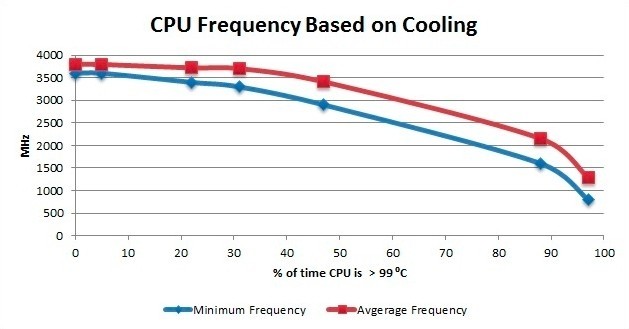
We were very surprised when our testing showed that while the minimum CPU load frequency started to drop as soon as the CPU hit 100 °C, the average CPU frequency didn't drop by more than .1GHz until the CPU was overheating more than 30% of the time. In fact, Intel CPUs are surprisingly good at being able to handle this much heat with such a small reduction in the average frequency.
While this is a great way to understand what is happening from a frequency standpoint, we wanted to know how this affects real-world performance. To do so, we recorded the Linpack performance results to see what the actual performance implications of overheating are:
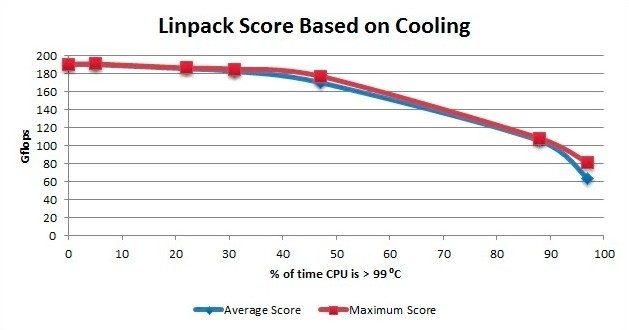
Linpack is one of the most consistent CPU benchmarks we have ever seen and the Intel Core i7 4790 should score right at 190 GFlops with the problem size we used for this testing (30000). What is interesting is that the Linpack results from our testing almost exactly follow the average CPU frequency from the previous graph. While it makes complete sense, this pretty much just confirms that from a strictly CPU performance point of view, the performance of a CPU is directly related to it's average frequency.
So what does this all mean? Beyond the fact that Intel CPUs are impressively stable even while technically overheating it means that you can expect full performance from an Intel CPU as long as you keep it below 100 °C. At the same time, even if the CPU occasionally hits 100 °C you shouldn't see more than a minimal drop in performance until it spends a significant amount of time (more than 20% of the time) above 99 °C.
While the information from the previous section is really interesting, it may be hard to translate into a real world situation. To help with this, we performed the exact same Linpack test except that instead of altering the cooling manually we used two different CPU coolers - the stock cooler that came bundled with the Core i7 4790 and the budget-friendly Cooler Master Hyper TX3 which only costs about $20. To make this as real-world as possible, we installed our test hardware (Asus Sabertooth Z97 Mark II, Intel Core i7 4790, 4x Kingston HyperX LoVo DDR3-1600 4GB, NVIDIA GeForce GTX 980) into a Fractal Design Define R4 chassis with the stock fans running at 5V.
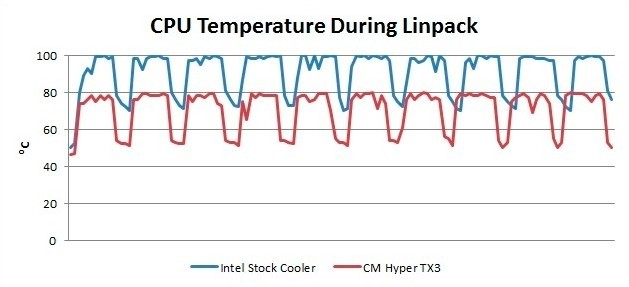
As you can see from the graph above, even a very affordable CPU cooler like the CM Hyper TX3 is able to dramatically lower the CPU temperature under load. While the stock cooler is easily hitting 100 °C during the benchmark run, the CM Hyper TX3 only ever hits a maximum temperature of 80 °C. In terms of how much the CPU was overheating, the stock cooler allowed the CPU to run at > 99 °C about 20% of the time.
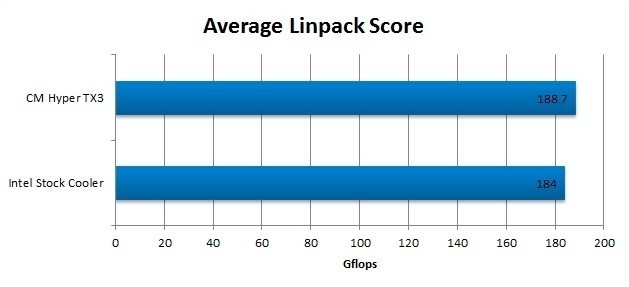
According to our graphs from the previous section, we should expect a measurable, albeit small, drop in performance with the stock cooler. We found that using the stock cooler made the CPU perform about 2.5% slower than it did with the CM Hyper TX3. The neat thing is that this drop in performance almost exactly lines up with our graphs of expected performance from the previous section.
The results of our testing can pretty much be summarized with the following three points:
Frankly, we were a bit surprised at how well modern Intel CPUs dealt with really high temperatures. They manage to run at full speed all the way up to 100 °C, and even then the performance is not greatly affected unless they spend a significant amount of time at that temperature. We certainly don't advocate letting your CPU run at those kinds of temperatures, however. While this article is about performance there are plenty of non-performance based reasons to keep your CPU temperature at a more reasonable level.

Sensitive electronics like CPUs have a finite lifespan and running them at higher temperatures shortens it. So unless you want to have an excuse to upgrade your system often, higher temperatures are counter-productive.
With PC hardware, higher temperatures make both minor and major hardware faults much more likely. These hardware faults can result in anything from reduced performance due to minor errors needing to be corrected to data corruption or bluescreens due to more dramatic errors.
The difficult thing is that just saying "lower temperatures are better" is an overly simplified way to look at CPU temperatures when you consider a PC as a whole. While you canuse giant liquid cooling loops, insanely high flow fans, or even things like liquid nitrogen to keep a CPU extremely well cooled those methods are either expensive, cumbersome, loud, or a combination of all three. In reality it is generally better to let the CPU run a little warm in order to properly balance the cooling against the heat output of the CPU.
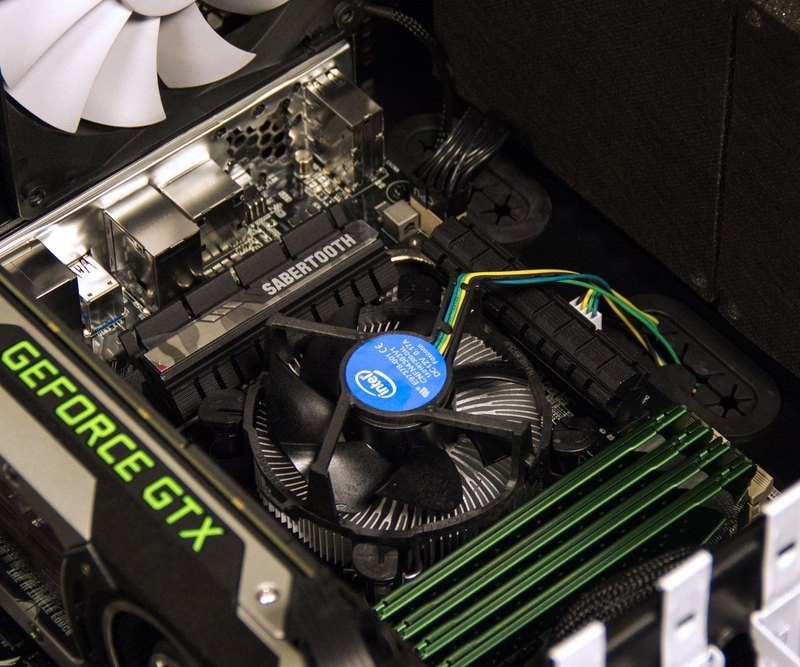
For example, the Corsair Hydro H60 is a great closed-loop CPU cooler used on most of Puget's high wattage CPUs, but it would be overkill for a low-wattage Intel Core i3 CPU. It would certainly keep the CPU well cooled, but it would be much louder, more complex (due to the liquid and pump), and more expensive than what is necessary. Instead, a CM Hyper TX3 or Gelid Tranquillo (if you want to have the system even quieter) would be a better match for that CPU even though the CPU would run slightly hotter under load.
For the average system, a rule of thumb at Puget Systems is that the CPU should run around 80-85 °C when put under full load for an extended period of time. This gives the CPU plenty of thermal headroom, does not greatly impact the CPU's lifespan, and keeps the system rock stable without overdoing it on cooling. Lower temperatures are, of course, better (within reason) but if you want a target to aim for, 80-85 °C is what we generally recommend.
 The cicadas aren't invading the U.S.
The cicadas aren't invading the U.S.
 #CarefreeBlackKids2k16 offers comfort in the midst of tragedy
#CarefreeBlackKids2k16 offers comfort in the midst of tragedy
 Hands on with Polaroid's OneStep+ instant camera with app connectivity
Hands on with Polaroid's OneStep+ instant camera with app connectivity
 The U.S. Open says it regrets warning a female tennis player for taking off her shirt
The U.S. Open says it regrets warning a female tennis player for taking off her shirt
 No Time for a Negative Peace
No Time for a Negative Peace
 Samsung's massive 8K QLED to hit stores in October
Samsung's massive 8K QLED to hit stores in October
 Our first look at the flagship 2018 iPhones is here
Our first look at the flagship 2018 iPhones is here
 Singer K'naan needs you to vote on his behalf in the U.S. midterm elections
Singer K'naan needs you to vote on his behalf in the U.S. midterm elections
 Hands on with the redesigned Wear OS by Google for smartwatches
Hands on with the redesigned Wear OS by Google for smartwatches
 Ireland fines TikTok $600 million for sharing user data with China
Ireland fines TikTok $600 million for sharing user data with China
 This female tennis player was penalized for removing her shirt
This female tennis player was penalized for removing her shirt
 10 states sue federal government over transgender bathroom policies
10 states sue federal government over transgender bathroom policies
 Google Assistant can now understand two different languages at once
Google Assistant can now understand two different languages at once
 Antigua GFC vs. Seattle Sounders 2025 livestream: Watch Concacaf Champions Cup for free
Antigua GFC vs. Seattle Sounders 2025 livestream: Watch Concacaf Champions Cup for free
 Snoop Dogg, the Game lead march to LAPD headquarters
Snoop Dogg, the Game lead march to LAPD headquarters
 'Parks and Rec' hero Aubrey Plaza comes out as queer
'Parks and Rec' hero Aubrey Plaza comes out as queer
 Teen discovers body in river while playing 'Pokémon Go'
Teen discovers body in river while playing 'Pokémon Go'
 'Black Mirror' Season 7: 'Hotel Reverie,' explained
'Black Mirror' Season 7: 'Hotel Reverie,' explained
 Twitter tests suggestions on people to unfollow for when your timeline is too much
Twitter tests suggestions on people to unfollow for when your timeline is too much
Microsoft Outlook Classic bug will will devour your CPU usageBest iPad deal: Save $20 on Apple Magic KeyboardNYT mini crossword answers for April 17, 2025Best Amazon deal: Save 28% on the Amazon Echo HubNYT mini crossword answers for April 17, 2025Best streaming deal: Get the Google TV Streamer 4K at Amazon for $79Best Sony deal: Save $51.99 on Sony ULT WEAR headphones at AmazonBest Dyson vacuum deal: Get a refurbished V8 or V15 Detect on sale at WalmartDoom: The Dark Ages Xbox controller preorder: Pre'28 Years Later' trailer is so intense you'll need a headache tabletBest Amazon deal: Save 28% on the Amazon Echo HubChatGPT introduces an image library to store your generated photosNYT mini crossword answers for April 17, 2025Best kitchen deal: Get the Ninja Slushi for $110 offThe Amazon Book Sale is coming April 23 through 28Best console deal: Get the Nintendo Switch OLED Model for under $250 at WootBest streaming deal: Get the Google TV Streamer 4K at Amazon for $79'28 Years Later' trailer is so intense you'll need a headache tabletBest tablet deal: Save $45 on the Amazon Fire Max 114chan down, reportedly hacked as of April 15 Nielsen is bringing its data and analysis expertise to esports Instrumments 01 measuring tool is mightier than the ruler An engineer designed two Nintendo Switch controller adapters to help make gaming more accessible The only 'Game of Thrones' recap we need is one made with corgis Los Angeles wants businesses to team up to fight cyber crime Guess who's back: Daniel Craig confirms return as James Bond July was one of Earth's warmest months in 137 years, NASA finds 'Game of Thrones' fan has an epic theory about what's in store for Bronn 'Overwatch' deathmatch was a mistake The price of eclipse glasses have more than tripled on Amazon over the last 2 weeks Why Apple's not going to sell an OLED TV Google can now warn you when your allergies might flare up Facebook is adding daily deals from Ebay to its marketplace Bonnie Tyler will perform flawless song 'Total Eclipse of the Heart' during the eclipse Chinese state media just released a terribly racist video mocking Indians Biggest theater chain to $9.99 Horde of Nintendo games and collectibles sells for $20,000 82nd Airborne calls out white supremacist for wearing their hat at Charlottesville Leaked images might show the iPhone 8's wireless charging pads Supermarket brings in 'quiet hour' designed to help autistic people
3.3579s , 10184.046875 kb
Copyright © 2025 Powered by 【Hindi Archives】,Wisdom Convergence Information Network